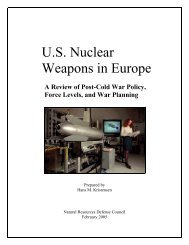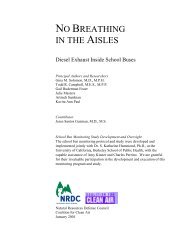p.53-94 (pdf) - Natural Resources Defense Council
p.53-94 (pdf) - Natural Resources Defense Council
p.53-94 (pdf) - Natural Resources Defense Council
You also want an ePaper? Increase the reach of your titles
YUMPU automatically turns print PDFs into web optimized ePapers that Google loves.
Appendix C U.S. Nuclear Weapons, Location Profiles, CONTINUED<br />
NEW MEXICO<br />
Rank: No. 1<br />
Nuclear Warheads: 2450<br />
Kirtland<br />
AIR FORCE BASE<br />
BECAUSE OF A BACKLOG OF WARHEADS awaiting dismantlement<br />
at the DOE’s Pantex facility near Amarillo, TX, the Kirtland<br />
Underground Munitions Storage Complex (KUMSC) at Kirtland<br />
AFB, Albuquerque, New Mexico has emerged as number one in<br />
U.S. nuclear warheads deployed in a single location, a rise from<br />
2nd place in 1992 and 11th place in 1985.<br />
Kirtland AFB serves as one of two main Air Force nuclear<br />
weapons general depots in the United States (the other is at Nellis<br />
AFB in Nevada). And because of its 300 mile proximity to Pantex,<br />
Kirtland serves as a transshipment base and storage point augmenting<br />
the disassembly facility. Nuclear weapons are stored in<br />
the newly built, partially underground KUMSC facility, managed<br />
by the 898th Munitions Squadron of the 377th Air Base Wing<br />
(ABW), a unit of the Air Force Materiel Command. The 377th Air<br />
Base Wing received excellent and outstanding ratings in its 19<strong>94</strong><br />
NSI. They had another NSI on June 21-30, 1997. The 898th MUNS<br />
is scheduled to receive an NSI on September 28, 1998.<br />
Kirtland AFB traces its origins to the 1920s when a private<br />
airstrip called Oxnard Field was created. In the late 1930’s Albuquerque’s municipal airport began<br />
operating in what is now the base’s west side, and in 1939, military activity began with the leasing of<br />
2000 acres. One of the country’s largest bomber crew training bases was created soon thereafter,<br />
and a training depot for aircraft mechanics (later known as Sandia Base) was established during the<br />
Second World War.<br />
In July 1<strong>94</strong>5, Los Alamos scientific director J. Robert Oppenheimer formed Z-Division to manage<br />
the engineering, design, production, assembly, and field testing of the non-nuclear components of<br />
atomic bombs. The need for flight support and test facilities reasonably near to the Los Alamos<br />
Laboratory led to the movement of the Division to Sandia in September 1<strong>94</strong>5. By July 1<strong>94</strong>6 transfer<br />
was almost complete and Z-Division moved into four new buildings, 828, 838, 824 and 839. The unit<br />
became the Sandia Corporation in 1<strong>94</strong>9 and later the Sandia National Laboratories, still the largest<br />
element and tenant at Kirtland.<br />
During the Cold War, Kirtland became the U.S. military center for nuclear weapons administration<br />
and operation. The Armed Forces Special Weapons Project (AFSWP) (later the <strong>Defense</strong> Atomic<br />
Support Agency-DASA, then the <strong>Defense</strong> Nuclear Agency-DNA, now the <strong>Defense</strong> Special Weapons<br />
Agency-DSWA) operated the Sandia Base from its creation in 1<strong>94</strong>7. In 1<strong>94</strong>9, the Air Force Special<br />
Weapons Command (disestablished in 1976) was also established at Kirtland, and in 1<strong>94</strong>9, the Naval<br />
Weapons Evaluation Facility, a Navy nuclear weapons research and test facility was established. It<br />
was joined by the Air Force Weapons Laboratory (which became the Phillips Laboratory in 1990). In<br />
1971, Kirtland and Sandia Base merged.<br />
In 1<strong>94</strong>5, nuclear weapons first came to the Sandia Base, and a special Manhattan District Military<br />
Police unit was established to guard the bombs as they were brought down from the Los Alamos<br />
laboratory for practice and operational loading on specially modified B-29 bombers. Nuclear warheads<br />
came for permanent storage in 1<strong>94</strong>9, when the Manzano Base Weapons Storage Area (“Site<br />
Worldwide Nuclear Deployments 1998 63
















